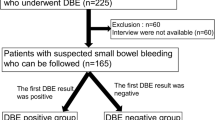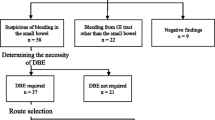Abstract
Until the development of wireless capsule endoscopy (CE) and double-balloon enteroscopy (DBE), it was extremely difficult to examine the entire small intestine. To assess the usefulness of DBE for diagnosing suspected small intestinal bleeding, we retrospectively compared the diagnoses and treatments of cases before and after its introduction at one hospital. Between September 2003 and December 2005, 21 consecutive patients with suspected small intestinal bleeding underwent DBE at Tokai University Hospital (group A), and subsequently 2 were excluded from the study after being diagnosed with bleeding from a diverticulum and an angiodysplasia in the ascending colon, respectively. For comparison, inpatients who were negative for gastrointestinal bleeding on colonoscopy and gastroscopy between May 1998 and August 2003 were reviewed and 27 consecutive patients who had not undergone DBE were selected as the control group (group B). All patients had been diagnosed negative for a source of bleeding on more than one colonoscopy and gastroscopy. There were no significant differences between the two groups in terms of age, gender, history of blood transfusion, blood hemoglobin value on admission, or symptoms. The diagnostic yield of DBE in identifying the source of bleeding was 78.9%: six cases of small intestinal ulcers, five cases of angiodysplasia, two cases of hard submucosal tumor (SMT), one case of small pulsating SMT, and one case of small intestinal cancer. DBE was also used to successfully treat three cases of angiodysplasia with argon plasma coagulation. In the control group, conventional investigations, including enteroclysis, angiography, Meckel scan, scintigraphy with technetium-labeled red blood cells, and/or push enteroscopy, were performed in 88.9%, 29.6%, 29.6%, 55.6%, and 25.9%, respectively. The overall diagnostic yield of the conventional approaches was only 11.1% (P < 0.01), comprising a Meckel's diverticulum, a polyp, and an angiodysplasia. We conclude that DBE can be used to diagnose suspected small intestinal bleeding and to treat some cases, such as angiodysplasia.


Similar content being viewed by others
References
Baum S, Athanasoulis CA, Waltman AD, Ring EJ (1973) Gastrointestinal hemorrhage. II. Angiographic diagnosis and control. Adv Surg 7:149–198
Rantis PC, Harford FJ, Wagner RH, Henkin RE (1995) Technetium-labeled red blood cell scintigraphy: is it useful in acute lower gastrointestinal bleeding? Int J Colorect Dis 10:210–215
Gutierrez C, Mariano M, Vander Laan T, Wang A, Faddis DM, Stain SC (1998) The use of technetium-labeled erythrocyte scintigraphy in the evaluation and treatment of lower gastrointestinal hemorrhage. Am Surg 64:989–992
Hayat M, Axon T, O’Mahony S (2000) Diagnostic yield and effect on clinical outcomes of push enteroscopy in suspected small-bowel bleeding. Endoscopy 32:369–372
Rabe FE, Becker GJ, Besozzi MJ, Miller RE (1981) Efficacy study of the small-bowel examination. Radiology 140:47–50
Rex DK, Lappas JC, Maglinte DDT, Malczewski MC, Kopecky KA, Cockerill EM (1989) Enteroclysis in the evaluation of suspected small intestinal bleeding. Gastroenterology 97:58–60
Brown CL, Olshaker JS (1988) Meckel's diverticulum. Am J Emerg Med 6:157–164
Costamagna G, Shah SK, Riccioni ME, Foschia F, Mutignani M, Perri V, Vecchioli A, Brizi MG, Picciocchi A, Marano P (2002) A prospective trial comparing small bowel radiographs and video capsule endoscopy for suspected small bowel disease. Gastroenterology 123:999–1005
Adler DG, Knipschield M, Gostout C (2004) A prospective comparison of capsule endoscopy and push enteroscopy in patients with GI bleeding of obscure origin. Gastrointest Endosc 59:492–498
Mylonaki M, Fritscher-Ravens A, Swain P (2003) Wireless capsule endoscopy: a comparison with push enteroscopy in patients with gastroscopy and colonoscopy negative gastrointestinal bleeding. Gut 52:1122–1126
Yamamoto H, Sekine Y, Sato Y, Higashizawa T, Miyata T, Iino S, Ido K, Sugano K (2001) Total enteroscopy with a nonsurgical steerable double-balloon method. Gastrointest Endosc 53:216–220
Yamamoto H, Kita H, Sunada K, Hayashi Y, Sato H, Yano T, Iwamoto M, Sekine Y, Miyata T, Kuno A, Ajibe H, Ido K, Sugano K (2004) Clinical outcomes of double-balloon endoscopy for the diagnosis and treatment of small-intestinal diseases. Clin Gastroenterol Hepatol 2:1010–1016
Matsumoto T, Moriyama T, Esaki M, Nakamura S, Iida M (2005) Performance of antegrade double-balloon enteroscopy: comparison with push enteroscopy. Gastrointest Endosc 62:392–398
Pennazio M, Santucci R, Rondonotti E, Abbiati C, Beccari G, Rossini FP, Franchis RD (2004) Outcome of patients with obscure gastrointestinal bleeding after capsule endoscopy: report of 100 consecutive cases. Gastroenterology 126:643–653
Cave DR (2005) Obscure gastrointestinal bleeding: the role of the tagged red blood cell scan, enteroscopy, and capsule endoscopy. Clin Gastroenterol Hepatol 3:959–963
Rex DK, Cutler CS, Lemmel GT, Rahmani EY, Clark DW, Helper DJ, Lehman GA, Mark DG (1997) Colonoscopic miss rates of adenomas determined by back-to-back colonoscopies. Gastroenterology 112:24–28
Haseman JH, Lemmel GT, Rahmani EY, Rex DK (1997) Failure of colonoscopy to detect colorectal cancer: evaluation of 47 cases in 20 hospitals. Gastrointest Endosc 54:451–455
Zuckerman GR, Prakesh C, Askin MP, Lewis BS (2000) AGA technical review on the evaluation and management of occult and obscure gastrointestinal bleeding. Gastroenterology 118:201–221
Farrell JJ, Friedman LS (2005) Review article: The management of lower gastrointestinal bleeding. Aliment Pharmacol Ther 21:1281–1298
Davies NM, Saleh JY, Skjodt NM (2000) Detection and prevention of NSAID-induced enteropathy. J Pharm Sci 3:137–155
Graham DY, Opekun AR, Willingham FF, Qureshi WA (2005) Visible small-intestinal mucosal injury in chronic NSAID users. Clin Gastroenterol Hepatol 3:55–59
Author information
Authors and Affiliations
Corresponding author
Rights and permissions
About this article
Cite this article
Suzuki, T., Matsushima, M., Okita, I. et al. Clinical Utility of Double-Balloon Enteroscopy for Small Intestinal Bleeding. Dig Dis Sci 52, 1914–1919 (2007). https://doi.org/10.1007/s10620-007-9749-9
Received:
Accepted:
Published:
Issue Date:
DOI: https://doi.org/10.1007/s10620-007-9749-9




